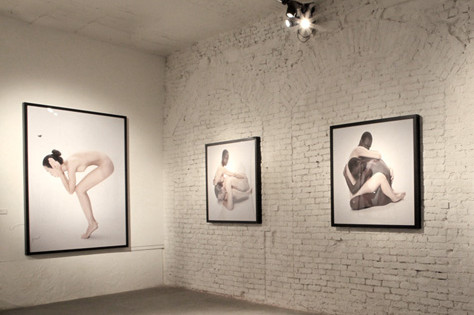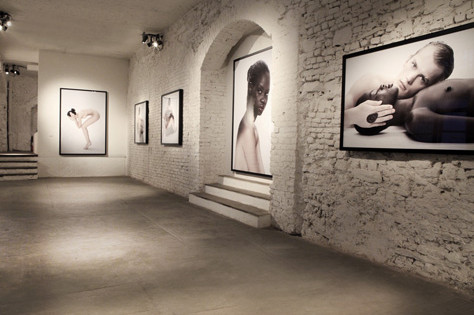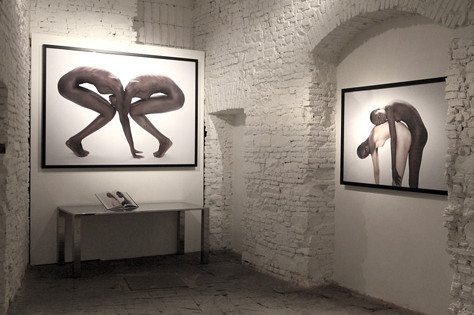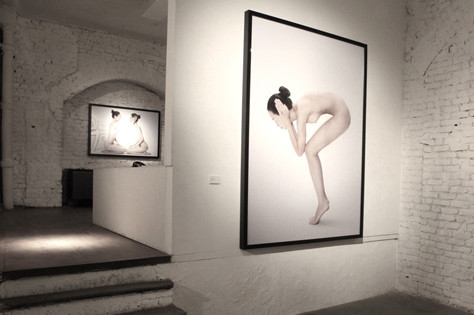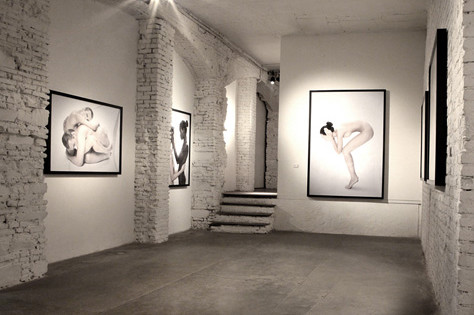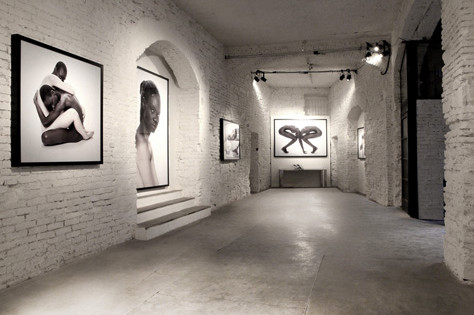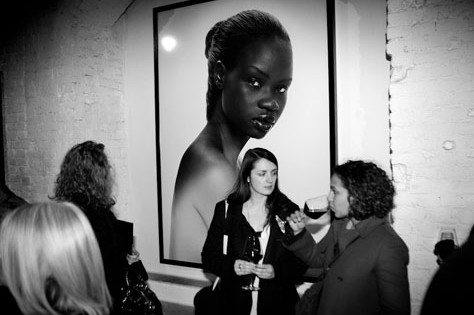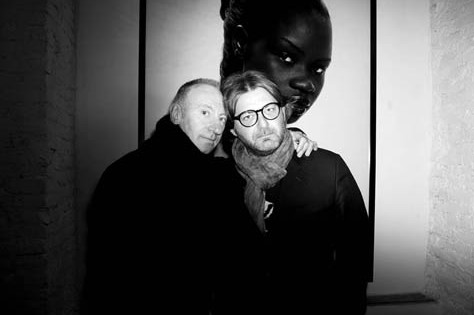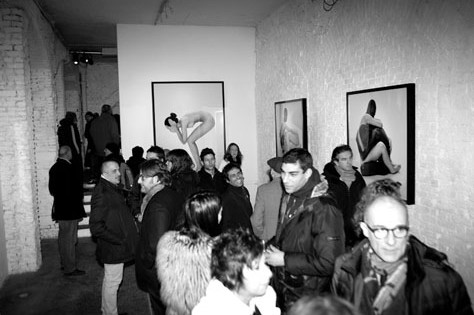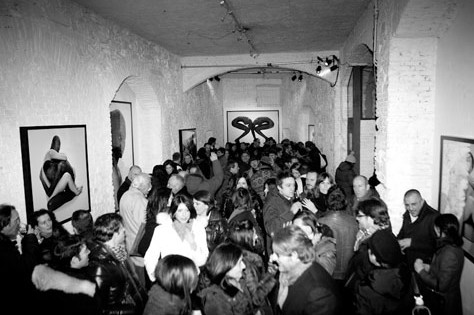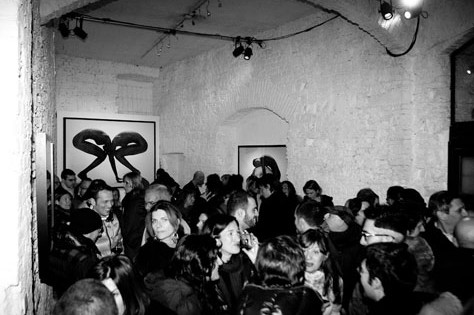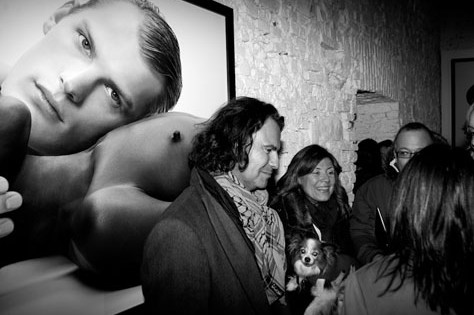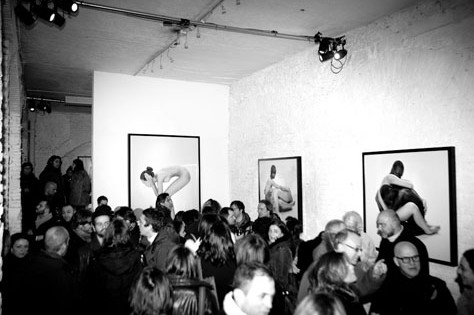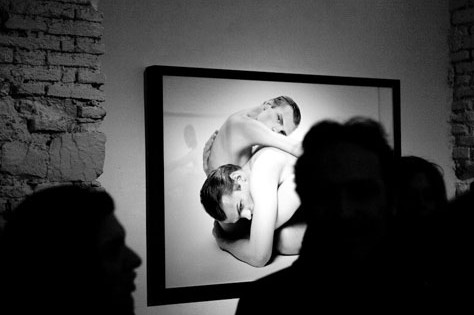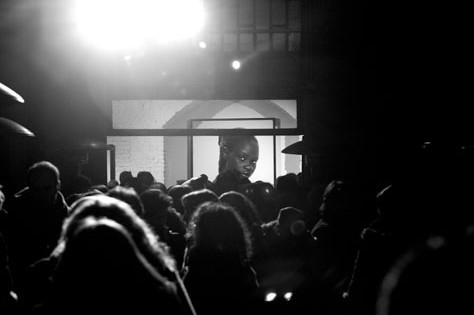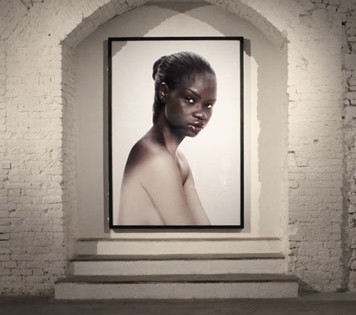GIUSEPPE MASTROMATTEO Indepensense 2012
Faces which mutate from white to black with infinite softness. The expression does not change and the fixity of a noble, courageous sentiment remains. The arms and legs of a couple merge to inflect a new grammar of the body. The equilibrium is that of a dream and it is natural to think: it seems real. But it is a sensation that remains suspended between that seeming and that need of truth which has always marked human intelligence.
Then, a continuous flux of hands and hair and ears and mouths—all stretched in the search for a natural transparence capable of sustaining beauty and fear.
Destiny and fate.
As for the rest, we are, in any case, used to accepting the transposition of reality onto a two-dimensional plane. The images are not only never real, but change over time and help us become aware of the physical world by way of vision, as Italo Zannier suggests in his introduction to the volume which accompanies the exhibit, “Sembianze.”
It’s like a role-playing game, this story which unfolds in a hybrid dimension, between reality and appearance, truth and distortion, construction and artifice. In order to participate, understand and interact, one needs to know the rules, define the parameters of the language, and know that the game is played in the neutral territory of contemporary art. Photography is the most important card, and once laid on the table its objectives automatically declare themselves, along with its aims, strategies, and ultimate expression.
The master of this process and the definer of its context is Giuseppe Mastromatteo, who, for a long time now, has been contributing to the enrichment of the collective imagination with new forms.
The renewed series of Indepensense was born while our creator was working in New York, where he had been transferred, as a creative director in advertising. This is his statement regarding the work: “…unlike the first time, this year I began the project by creating splatters on paper, sketches here and there, digital notes, and photographs from a mobile phone. I also rented a photography studio in Brooklyn. The set was constructed several times over and abandoned often. I had a different aesthetic in mind with regard to the first edition of Indepensense; I almost had to negate that which I did previously. But it wasn’t the aesthetic that had to change or evolve, it was, rather, an intuition that buzzed in my head and that I had to fine tune: the idea of a photographic work which knew how to join sincerity with a more conscious form of authenticity, without ceasing to amaze, above all, myself.”
Thus Indepensense is, this time, more than the superimposition of the senses. Taking precedence here is a completely new idea of the body; a body which becomes the means by which to tell of the crisscrossing of cultures, populations, religions and genders. This time the camera becomes a clear point of observation upon a reality which has nothing to do with memories. The framework expands to comprise the entire body, and the senses mingle. The skin becomes an occasion for meaning, for the will of comprehension—capable of transforming everything in panorama: a human panorama which is created little by little and which does not consider contemplation. It’s all of a piece; there is no beginning and there is no end. There is no narration. Indepensense is transformed in order to invent new forms of connection and crossovers, creating opportunities for contemporary human belonging.
To this end, Mastromatteo states: “The body is transformed into an idea, a territory where things and actions happen. I’m interested in describing the crisscrossing of the races, the capacity of uniting different worlds and cultures in one unique body, otherwise impossible to imagine. In one unique body opposing races, opposing worlds and different cultures—along with the body—become scenery, a stage. Two bodies become one—they transform themselves in order to abandon their singularity and become a new human being which doesn’t yet exist. It is the abandoning of the self in order to embrace a new dimension.”
Lined up one after the other, these bodies form a sort of long sequence shot. They are the quotidian gestures which, repeated like a mantra, in their simplicity, illustrate the use of a democratic and accessible primer, and which end up pointing to a possible direction: these faces and bodies and interweavings and embraces define, first of all, a “human quantity,” otherwise perceptible only in the dream dimension.
From this point of view, technology is the only tool which permits the relating of this new world and this new human race, which is otherwise destined to remain child only of the imagination.
If contemporary art was and is a seismograph capable of registering changes and disturbances in society, Giuseppe Mastromatteo has discovered the sensitive tools for rendering this hypothetical implement still more accurately. His language deals not only with a skillful manipulation, but it speaks to us of poetry lending its attention to aesthetics. It speaks to us of sleepy sentiments which show excitement upon awakening, of a re-found energy which communicates with the theme of new identities and closes the circle of an urgent and relevant reasoning: the theme of authenticity, knowing that things in the world are never still and, moreover, remain elusive.
Mastromatteo, in the end, disrupts the cards. He surprises. He bides his time. He frees himself from the concept of genre and in the role of artist-director defines new trajectories. From the ruins of recent history, he engraves the codes of new sentiments, useful to new generations. The alphabet of change must resemble that of innovation.
_______________________________________________________________
Volti che mutano dal bianco al nero con infinita morbidezza. L’espressione non cambia e resta la fissità di un sentimento nobile, coraggioso. Le braccia e le gambe di una coppia si fondono per declinare una nuova grammatica del corpo. L’equilibrio è quello del sogno ed è naturale pensare: sembra vero.Ma è una sensazione che resta sospesa tra quel sembrare e quel bisogno di verità che da sempre contraddistingue l’intelligenza umana.
Poi un flusso continuo di mani e capelli e orecchie e bocche, tutto teso alla ricerca di una trasparenza naturale in grado di sorreggere bellezza e paura.
Destino e fatalità.
Del resto, siamo ormai abituati ad accettare la trasposizione della realtà sul piano bidimensionale. Le immagini non solo non sono mai vere, ma cambiano nel tempo e ci aiutano a prendere coscienza del mondo fisico attraverso la visione, come suggerisce Italo Zannier nella sua introduzione al volume che accompagna la mostra “Sembianze”.
E come in un gioco di ruolo, questa storia si svolge in una dimensione ibrida, tra realtà e apparenza. Verità e alterazione. Costruzione e artificio. Per partecipare, capire e interagire occorre conoscere le regole, definire i parametri del linguaggio e sapere che la partita si gioca nel territorio neutro dell’arte contemporanea. La fotografia è la carta più importante e una volta posata sul tavolo, si dichiarano automaticamente gli obiettivi, le finalità, le strategie, il punto di arrivo.
A comandare il percorso e a definire il contesto è Giuseppe Mastromatteo che, da tempo ormai, contribuisce ad arricchire l’immaginario collettivo con nuove figure.
La rinnovata serie di Indepensense nasce mentre il nostro autore è in trasferta a New York per il suo lavoro di direttore creativo per l’advertising.
Questa la sua testimonianza sulla produzione: “…a differenza della prima volta, quest'anno ho cominciato il progetto realizzando schizzi su carta abbozzati qua e là, appunti digitali, fotografie con il telefonino. Ho anche noleggiato uno studio fotografico a Brooklyn. Il set è stato più volte costruito e spesso abbandonato. Avevo in mente una diversa estetica rispetto alla prima edizione Indepensense, quasi dovessi negare ciò che avevo fatto in precedenza. Ma non era l'estetica che doveva cambiare o evolvere, era, piuttosto, un’intuizione che ronzava in testa e che dovevo mettere a punto: l’idea di un lavoro fotografico che sapesse coniugare la sincerità con una più consapevole forma di autenticità, senza smettere di stupire, prima di tutto, me stesso”.
Così, Indepensense, questa volta, è qualcosa di più della sovrapposizione dei sensi. Qui, a prevalere, è un’idea tutta nuova del corpo. Un corpo che diventa occasione per raccontare dello sconfinamento tra culture, popolazioni, religioni, genere. Questa volta la macchina da presa diventa un chiaro punto di osservazione su una realtà che nulla ha a che fare con il ricordo. L’inquadratura si allarga al corpo intero e i sensi si mischiano. La pelle diventa occasione di senso, volontà di comprensione, capace di trasformare tutto in paesaggio. Un paesaggio umano che si fa via via percorso progettuale e che non tiene in conto la contemplazione. E’ tutto di un pezzo. Non c’è inizio e non c’è fine. Non c’è narrazione. Indipensense si trasforma per inventarsi nuove forme di connessione e sconfinamento, generando occasioni di appartenenza umana contemporanea.
A questo proposito, Mastromatteo precisa: “Il corpo si è trasformato in un’idea, un territorio dove succedono cose e fatti. Mi interessa descrivere lo sconfinamentodelle razze, la capacità di unire in un unico corpo diversi mondi e culture, altrimenti impossibili da immaginare.In un unico corpo convivono razze opposte, mondi opposti, culture diverse e il corpo diventa uno scenario, un palcoscenico. Due corpi diventano uno, si trasformano per abbandonare la loro singolarità e diventano un essere umano nuovo che non esiste ancora. E’ l’abbandono del se per abbracciare una nuova dimensione”.
Messi in fila uno dopo l’altro, questi corpi formano una sorta di lungo piano sequenza. Sono i gesti quotidiani che, ripetuti come un mantra, nella loro semplicità illustrano l’utilizzo di un abecedario democratico e accessibile, fino a indicare una direzione possibile: questi volti e corpi e intrecci e abbracci definiscono, anzitutto, una “quantità umana”, diversamente percepibile solo nella dimensione onirica.
Da questo punto di vista, la tecnologia è l'unico tools che permette di poter raccontare questo nuovo mondo e questa nuova razza umana destinata, altrimenti, a restare figlia solo dell'immaginazione.
Se l’arte contemporanea è stata ed è un sismografo capace di registrare cambiamenti e turbamenti della società, Giuseppe Mastromatteo ha individuato gli strumenti sensibili per rendere ancora più preciso l’ipotetico strumento. Il suo linguaggio non ha a che fare solo con una sapiente manipolazione, ma ci parla di poesia prestando attenzione all’estetica. Ci parla di sentimenti sopiti che provano l’emozione del risveglio. Di una ritrovata energia che dialoga con il tema delle nuove identità e chiude il cerchio di un ragionamento urgente e attuale: il tema dell’autenticità, sapendo che le cose del mondo non stanno mai ferme e, per lo più, restano imprendibili.
Mastromatteo, alla fine, spariglia le carte. Sorprende. Gioca d’anticipo. Si libera dal concetto di genere e nel ruolo di regista-artista definisce nuove traiettorie. Dalle macerie della storia recente incide i codici di nuovi sentimenti, utili alle nuove generazioni. L’alfabeto del cambiamento deve assomigliare a quello dell’innovazione.
Then, a continuous flux of hands and hair and ears and mouths—all stretched in the search for a natural transparence capable of sustaining beauty and fear.
Destiny and fate.
As for the rest, we are, in any case, used to accepting the transposition of reality onto a two-dimensional plane. The images are not only never real, but change over time and help us become aware of the physical world by way of vision, as Italo Zannier suggests in his introduction to the volume which accompanies the exhibit, “Sembianze.”
It’s like a role-playing game, this story which unfolds in a hybrid dimension, between reality and appearance, truth and distortion, construction and artifice. In order to participate, understand and interact, one needs to know the rules, define the parameters of the language, and know that the game is played in the neutral territory of contemporary art. Photography is the most important card, and once laid on the table its objectives automatically declare themselves, along with its aims, strategies, and ultimate expression.
The master of this process and the definer of its context is Giuseppe Mastromatteo, who, for a long time now, has been contributing to the enrichment of the collective imagination with new forms.
The renewed series of Indepensense was born while our creator was working in New York, where he had been transferred, as a creative director in advertising. This is his statement regarding the work: “…unlike the first time, this year I began the project by creating splatters on paper, sketches here and there, digital notes, and photographs from a mobile phone. I also rented a photography studio in Brooklyn. The set was constructed several times over and abandoned often. I had a different aesthetic in mind with regard to the first edition of Indepensense; I almost had to negate that which I did previously. But it wasn’t the aesthetic that had to change or evolve, it was, rather, an intuition that buzzed in my head and that I had to fine tune: the idea of a photographic work which knew how to join sincerity with a more conscious form of authenticity, without ceasing to amaze, above all, myself.”
Thus Indepensense is, this time, more than the superimposition of the senses. Taking precedence here is a completely new idea of the body; a body which becomes the means by which to tell of the crisscrossing of cultures, populations, religions and genders. This time the camera becomes a clear point of observation upon a reality which has nothing to do with memories. The framework expands to comprise the entire body, and the senses mingle. The skin becomes an occasion for meaning, for the will of comprehension—capable of transforming everything in panorama: a human panorama which is created little by little and which does not consider contemplation. It’s all of a piece; there is no beginning and there is no end. There is no narration. Indepensense is transformed in order to invent new forms of connection and crossovers, creating opportunities for contemporary human belonging.
To this end, Mastromatteo states: “The body is transformed into an idea, a territory where things and actions happen. I’m interested in describing the crisscrossing of the races, the capacity of uniting different worlds and cultures in one unique body, otherwise impossible to imagine. In one unique body opposing races, opposing worlds and different cultures—along with the body—become scenery, a stage. Two bodies become one—they transform themselves in order to abandon their singularity and become a new human being which doesn’t yet exist. It is the abandoning of the self in order to embrace a new dimension.”
Lined up one after the other, these bodies form a sort of long sequence shot. They are the quotidian gestures which, repeated like a mantra, in their simplicity, illustrate the use of a democratic and accessible primer, and which end up pointing to a possible direction: these faces and bodies and interweavings and embraces define, first of all, a “human quantity,” otherwise perceptible only in the dream dimension.
From this point of view, technology is the only tool which permits the relating of this new world and this new human race, which is otherwise destined to remain child only of the imagination.
If contemporary art was and is a seismograph capable of registering changes and disturbances in society, Giuseppe Mastromatteo has discovered the sensitive tools for rendering this hypothetical implement still more accurately. His language deals not only with a skillful manipulation, but it speaks to us of poetry lending its attention to aesthetics. It speaks to us of sleepy sentiments which show excitement upon awakening, of a re-found energy which communicates with the theme of new identities and closes the circle of an urgent and relevant reasoning: the theme of authenticity, knowing that things in the world are never still and, moreover, remain elusive.
Mastromatteo, in the end, disrupts the cards. He surprises. He bides his time. He frees himself from the concept of genre and in the role of artist-director defines new trajectories. From the ruins of recent history, he engraves the codes of new sentiments, useful to new generations. The alphabet of change must resemble that of innovation.
_______________________________________________________________
Volti che mutano dal bianco al nero con infinita morbidezza. L’espressione non cambia e resta la fissità di un sentimento nobile, coraggioso. Le braccia e le gambe di una coppia si fondono per declinare una nuova grammatica del corpo. L’equilibrio è quello del sogno ed è naturale pensare: sembra vero.Ma è una sensazione che resta sospesa tra quel sembrare e quel bisogno di verità che da sempre contraddistingue l’intelligenza umana.
Poi un flusso continuo di mani e capelli e orecchie e bocche, tutto teso alla ricerca di una trasparenza naturale in grado di sorreggere bellezza e paura.
Destino e fatalità.
Del resto, siamo ormai abituati ad accettare la trasposizione della realtà sul piano bidimensionale. Le immagini non solo non sono mai vere, ma cambiano nel tempo e ci aiutano a prendere coscienza del mondo fisico attraverso la visione, come suggerisce Italo Zannier nella sua introduzione al volume che accompagna la mostra “Sembianze”.
E come in un gioco di ruolo, questa storia si svolge in una dimensione ibrida, tra realtà e apparenza. Verità e alterazione. Costruzione e artificio. Per partecipare, capire e interagire occorre conoscere le regole, definire i parametri del linguaggio e sapere che la partita si gioca nel territorio neutro dell’arte contemporanea. La fotografia è la carta più importante e una volta posata sul tavolo, si dichiarano automaticamente gli obiettivi, le finalità, le strategie, il punto di arrivo.
A comandare il percorso e a definire il contesto è Giuseppe Mastromatteo che, da tempo ormai, contribuisce ad arricchire l’immaginario collettivo con nuove figure.
La rinnovata serie di Indepensense nasce mentre il nostro autore è in trasferta a New York per il suo lavoro di direttore creativo per l’advertising.
Questa la sua testimonianza sulla produzione: “…a differenza della prima volta, quest'anno ho cominciato il progetto realizzando schizzi su carta abbozzati qua e là, appunti digitali, fotografie con il telefonino. Ho anche noleggiato uno studio fotografico a Brooklyn. Il set è stato più volte costruito e spesso abbandonato. Avevo in mente una diversa estetica rispetto alla prima edizione Indepensense, quasi dovessi negare ciò che avevo fatto in precedenza. Ma non era l'estetica che doveva cambiare o evolvere, era, piuttosto, un’intuizione che ronzava in testa e che dovevo mettere a punto: l’idea di un lavoro fotografico che sapesse coniugare la sincerità con una più consapevole forma di autenticità, senza smettere di stupire, prima di tutto, me stesso”.
Così, Indepensense, questa volta, è qualcosa di più della sovrapposizione dei sensi. Qui, a prevalere, è un’idea tutta nuova del corpo. Un corpo che diventa occasione per raccontare dello sconfinamento tra culture, popolazioni, religioni, genere. Questa volta la macchina da presa diventa un chiaro punto di osservazione su una realtà che nulla ha a che fare con il ricordo. L’inquadratura si allarga al corpo intero e i sensi si mischiano. La pelle diventa occasione di senso, volontà di comprensione, capace di trasformare tutto in paesaggio. Un paesaggio umano che si fa via via percorso progettuale e che non tiene in conto la contemplazione. E’ tutto di un pezzo. Non c’è inizio e non c’è fine. Non c’è narrazione. Indipensense si trasforma per inventarsi nuove forme di connessione e sconfinamento, generando occasioni di appartenenza umana contemporanea.
A questo proposito, Mastromatteo precisa: “Il corpo si è trasformato in un’idea, un territorio dove succedono cose e fatti. Mi interessa descrivere lo sconfinamentodelle razze, la capacità di unire in un unico corpo diversi mondi e culture, altrimenti impossibili da immaginare.In un unico corpo convivono razze opposte, mondi opposti, culture diverse e il corpo diventa uno scenario, un palcoscenico. Due corpi diventano uno, si trasformano per abbandonare la loro singolarità e diventano un essere umano nuovo che non esiste ancora. E’ l’abbandono del se per abbracciare una nuova dimensione”.
Messi in fila uno dopo l’altro, questi corpi formano una sorta di lungo piano sequenza. Sono i gesti quotidiani che, ripetuti come un mantra, nella loro semplicità illustrano l’utilizzo di un abecedario democratico e accessibile, fino a indicare una direzione possibile: questi volti e corpi e intrecci e abbracci definiscono, anzitutto, una “quantità umana”, diversamente percepibile solo nella dimensione onirica.
Da questo punto di vista, la tecnologia è l'unico tools che permette di poter raccontare questo nuovo mondo e questa nuova razza umana destinata, altrimenti, a restare figlia solo dell'immaginazione.
Se l’arte contemporanea è stata ed è un sismografo capace di registrare cambiamenti e turbamenti della società, Giuseppe Mastromatteo ha individuato gli strumenti sensibili per rendere ancora più preciso l’ipotetico strumento. Il suo linguaggio non ha a che fare solo con una sapiente manipolazione, ma ci parla di poesia prestando attenzione all’estetica. Ci parla di sentimenti sopiti che provano l’emozione del risveglio. Di una ritrovata energia che dialoga con il tema delle nuove identità e chiude il cerchio di un ragionamento urgente e attuale: il tema dell’autenticità, sapendo che le cose del mondo non stanno mai ferme e, per lo più, restano imprendibili.
Mastromatteo, alla fine, spariglia le carte. Sorprende. Gioca d’anticipo. Si libera dal concetto di genere e nel ruolo di regista-artista definisce nuove traiettorie. Dalle macerie della storia recente incide i codici di nuovi sentimenti, utili alle nuove generazioni. L’alfabeto del cambiamento deve assomigliare a quello dell’innovazione.

